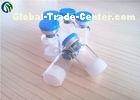Brand:-
Model:-
MOQ:-0 -
Bodybuilding Supplement PEGylated Mechano Growth Factor PEG MGF 2mg per vial
MGF is a splice variant of the IGF gene which increases stem cell count in the muscle and allows for muscle fibers to fuse and mature.
This is a process required for growth of adult muscle. Natural MGF is made locally and does not travel into the bloodstream.
Synthetic MGF is water based and when administered intramuscularly, travels into the bloodstream. MGF is only stable in the blood stream for only a few minutes.
PEGylation is the act of attaching a Polyethylene glycol (PEG) structure to another larger molecule (in this case, MGF).
The PEG acts as a protective coating and the theory here is that this will allow the MGF to be carried through the blood stream without being broken down.
MGF is produced biologically when muscle fibers are broken down through resistance (weight training). It is a potent factor in muscle growth.
MGF stimulates muscle growth, creates new muscle fibers, promotes nitrogen retention and increases protein synthesis.
The Effects of Pegylated MGF
Mechano Growth Factor (MGF) exhibits local effects in skeletal muscle and without cannot travel through the body without modification. The problem with synthetic Mechano Growth Factor (MGF) is that it is introduced intramuscularly and is water based so it goes into the blood stream. When used this way, Mechano Growth Factor (MGF) only remains stable in the blood stream for a few minutes. Biologically produced MGF is made locally and does not enter the bloodstream. It is also short acting so stability is not an issue. By PEGylating the Mechano Growth Factor (MGF) it is almost as efficient as local produced Mechano Growth Factor (MGF) when used intramuscularly. This is accomplished by surrounding part of the peptide with a structure of polyethylene glycol, which can be attached to a protein molecule. The polyethylene glycol groups protect the peptide but do not surround it completely. The active sites of the peptide are still free to do their biological function. In this case the shell is a negative charged shield against positively charged compounds that would affect the protein.




